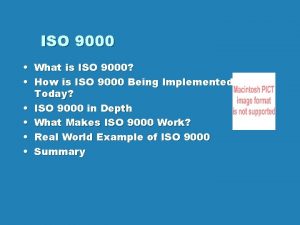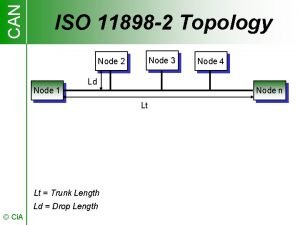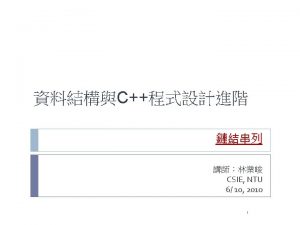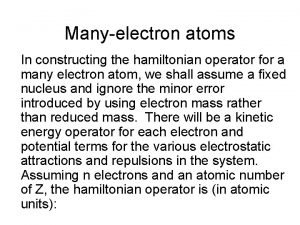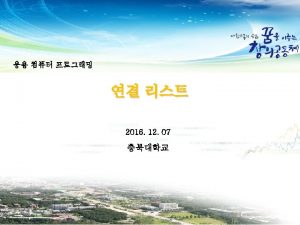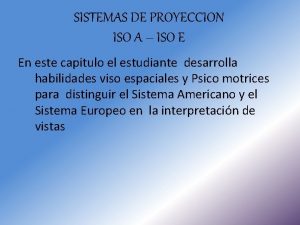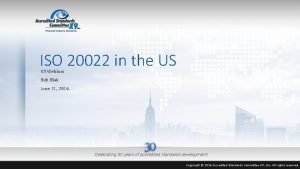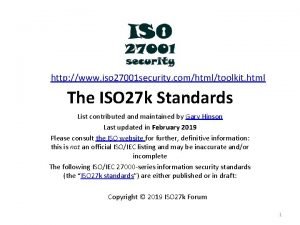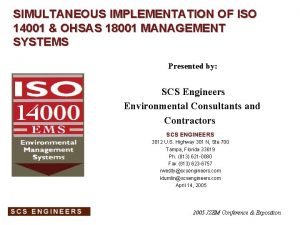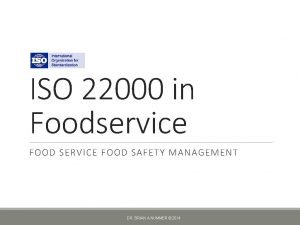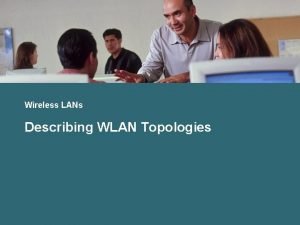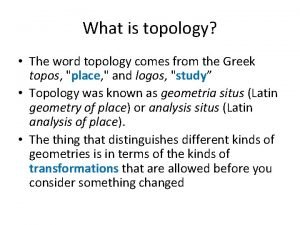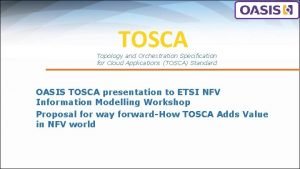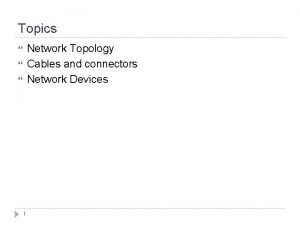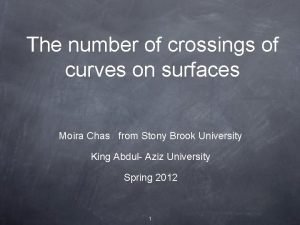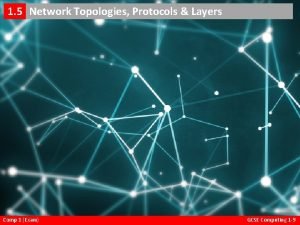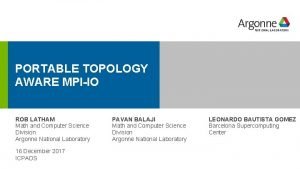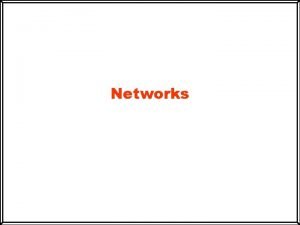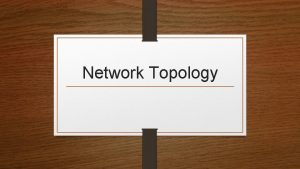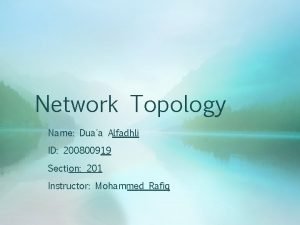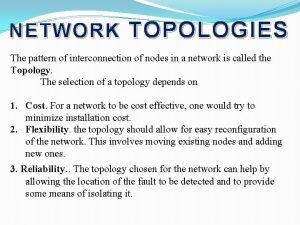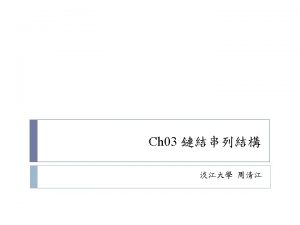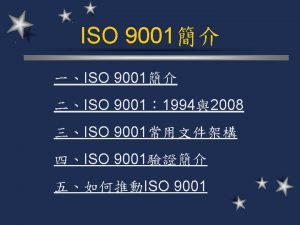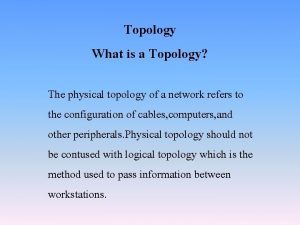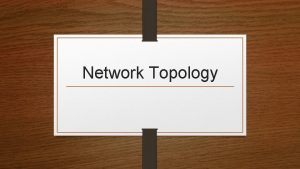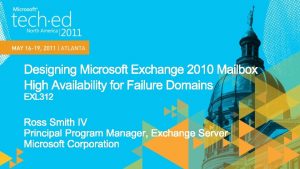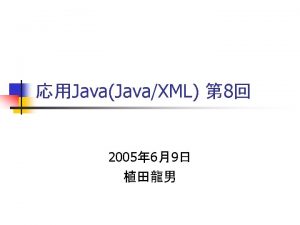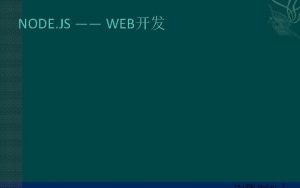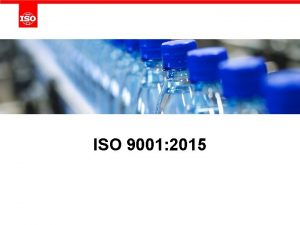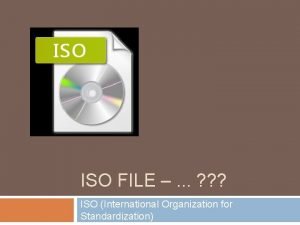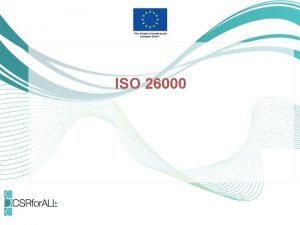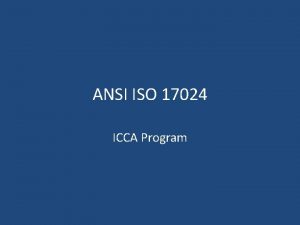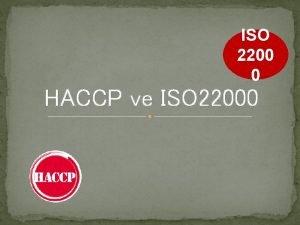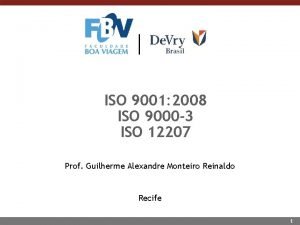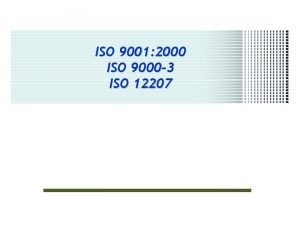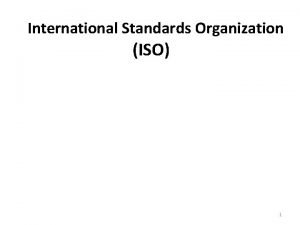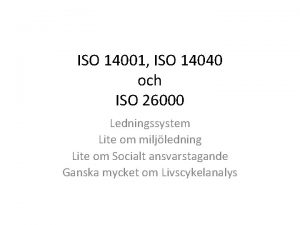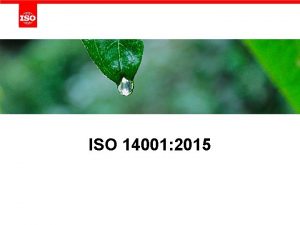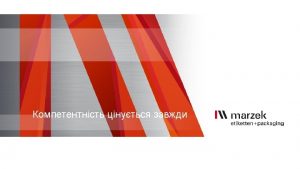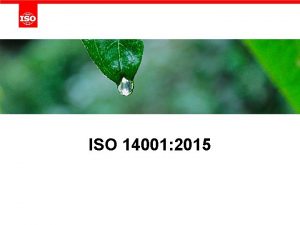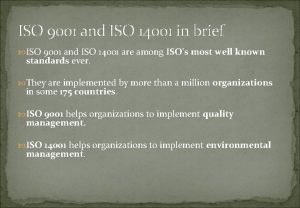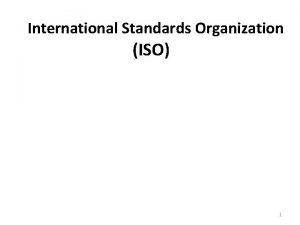CAN ISO 11898 2 Topology Node 3 Node













![CAN Data-rate/Bus-length Ratio [Mbit/s] 1. 6 u 1. 0 u 0. 9 0. 8 CAN Data-rate/Bus-length Ratio [Mbit/s] 1. 6 u 1. 0 u 0. 9 0. 8](https://slidetodoc.com/presentation_image/5b1dc70c15a33236c6f753cc2e8215a2/image-14.jpg)













- Slides: 27

CAN ISO 11898 -2 Topology Node 3 Node 2 Node 1 Ld Node n Lt Lt = Trunk Length Ld = Drop Length © Ci. A Node 4

CAN ISO 11898 -2 Network Setup node 1 . . . . node n CAN Bus Line CAN_L © Ci. A 120 CAN_H

CAN Electromagnetic Interference V EMI Vdiff = const CAN_H CAN Bus Line 120 Vdiff © Ci. A CAN_L t 120

CAN Nominal Bus Level min. 1 µs Voltage 5 V CAN_H 3. 5 V 2. 5 V CAN_H + CAN_L 1. 5 V 0 V Recessive © Ci. A Dominant Recessive Time

CAN Broadcast Communication CAN Station 1 (Consumer) CAN Station 2 (Producer) CAN Station 3 (Consumer) CAN Station 4 (Consumer) Local Intelligence Filter Frame I Filter bus lines © Ci. A Filter

CAN Remote Request CAN Station 1 (Requester) CAN Station 2 (Producer) CAN Station 3 (Consumer) CAN Station 4 (Consumer) Local Intelligence RTR I Frame I Filter bus lines © Ci. A Filter

CAN Multiple Bus Access CAN Station 1 CAN Station 2 CAN Station 3 Local Intelligence Frame 2 Filter Frame I Filter bus lines © Ci. A Filter CAN Station 4 Local Intelligence Frame 3 Filter

CAN Data Frame S Bus Arbitration O Idle Field F 1 Bit 12 or 32 Bit Control Field 6 Bit Data Field CRC ACK EOF Field 0 to 8 Byte 16 Bit 2 Bit 7 Bit Remark: CAN Specification 2. 0 B passive implementations can’t store or transmit Extended Data Frames; CAN Specification 2. 0 B active implementations can store and transmit Standard Data Frames as well as Extended Data Frames. © Ci. A IFS 3 Bit

CAN Remote Frame S Bus Arbitration O Idle Field F 1 Bit 12 or 32 Bit Control CRC ACK Inter. EOF Field Mission 6 Bit 16 Bit 2 Bit 7 Bit 3 Bit u CAN controller with receive buffer or receive FIFOs answers Remote Frames only under CPU control. u CAN Controller with standard message storing answers Remote Frame automatically without CPU control. u CAN Controller with advanced message storing answers Remote Frames automatically and optionally under CPU control. © Ci. A

CAN Arbitration Field Base Frame Format Arbitration Field Control Field Data Field SOF 11 bit Identifier RTR IDE r 0 DLC Extended Frame Format Arbitration Field Control Field SOF 11 bit Identifier SRR IDE 18 bit Identifier RTR r 1 r 0 DLC Trade-off: longer bus latency time (20 bit-times) longer frames (20 bit-times plus stuff-bits) reduced CRC performance © Ci. A

CAN Bus Arbitration Method Node 1 ID 100 Data ID 20 Node 2 ID 80 Node 3 Bus ID 100 Data Frame transmission request © Ci. A Data ID 20 Data ID 80 Data

CAN Collision Avoidance S R O Identifier T Control F 10 9 8 7 6 5 4 3 2 1 0 R Field Node 1 (Tx) Node 2 (Tx) Node 3 (Tx) Node 4 (Tx) recessive Bus (4 x Rx) dominant © Ci. A Data Field Listening Mode DLC Listening Mode Data

CAN Communication Services Producer request Write Object Consumer(s) indication(s) 0 to 8 Byte CAN Data Frame indication Read Object request(s) CAN Remote Frame response 0 to 8 Byte CAN Data Frame © Ci. A confirmation(s)
![CAN DatarateBuslength Ratio Mbits 1 6 u 1 0 u 0 9 0 8 CAN Data-rate/Bus-length Ratio [Mbit/s] 1. 6 u 1. 0 u 0. 9 0. 8](https://slidetodoc.com/presentation_image/5b1dc70c15a33236c6f753cc2e8215a2/image-14.jpg)
CAN Data-rate/Bus-length Ratio [Mbit/s] 1. 6 u 1. 0 u 0. 9 0. 8 u 0. 7 0. 6 0. 5 u 0. 4 0. 3 0. 2 0. 1 u 0. 1 0. 2 0. 3 © Ci. A u 0. 4 0. 5 0. 6 0. 7 0. 8 0. 9 u u 1. 0 1. 1 1. 2 [km]

CAN © Ci. A Practical Bus Length Bit Rate Bus Length Nominal Bit-Time 1 Mbit/s 800 kbit/s 500 kbit/s 250 kbit/s 125 kbit/s 62. 5 kbit/s 20 kbit/s 10 kbit/s 30 m 50 m 100 m 250 m 500 m 1000 m 2500 m 5000 m 1 µs 1. 25 µs 2 µs 4 µs 8 µs 20 µs 50 µs 100 µs

CAN ISO 11898 -2 Parameter DC Parameter • Length-Related Resistance (r): 70 m /m • Termination Resistor (Rt): nominal 120 (min. 108 , max. 132 ) AC Parameter • Impedance (Z): nominal 120 (min. 108 , max. 132 ) • Specific Line Delay: 5 ns/m © Ci. A

CAN DC Characteristics Bus Cable Bus Length. Related Resistance Bus-Line Cross-Section 0. . 40 m 70 m /m 0. 25 mm 2. . 0. 34 mm 2 AWG 23, AWG 22 124 (1%) 1 Mbit/s at 40 m <60 m /m 0. 34 mm 2. . 0. 6 mm 2 AWG 22, AWG 20 127 (1%) 500 Kbit/s at 100 m 300. . 600 m <40 m /m 0. 5 mm 2. . 0. 6 mm 2 AWG 20 600 m. . 1 km <26 m /m 0. 75 mm 2. . 0. 8 mm 2 AWG 18 40. . 300 m © Ci. A Termination Max. Resistance Baudrate 150 to 300 100 Kbit/s at 500 m 50 Kbit/s at 1 k m

CAN Cable Drop Length Rules of thumb for the maximum length of a unterminated cable drop Ld and for the cumulative drop length Ldi: n Ldi < t. PROPSEG / ( 10 * t. P ) Ld < t. PROPSEG / ( 50 * t. P ) i=1 t. PROPSEG : length of the propagation segment of the bit period t. P : specific line delay per length unit Example: bit rate = 500 kbit/s: t. PROPSEG = 12 * 125 ns = 1500 ns; t. P = 5 ns/m n Ld < 1500 ns / (50 * 5 ns/m) = 6 m; Ldi < 1500 ns /(10 * 5 ns/m) = 30 m i=1 © Ci. A

CAN © Ci. A DS-102 Baudrate

CAN Ci. A DS-102 Pin Assignment 9 -pin D-Sub: DIN 41652 © Ci. A Pin 1 2 3 4 5 6 7 8 9 Signal CAN_L CAN_GND (CAN_SHLD) GND CAN_H (CAN_V+) Description Reserved CAN_L bus line dominant low CAN Ground Reserved Optional CAN Shield Optional Ground CAN_H bus line dominant high Reserved Optional CAN external supply

CAN node sales figures 355 273 2002 203 2001 120 2000 57 1999 31 1998 2000 sales by regions: Europe: 85% America: 9% Asia: 6% © Ci. A 32 -bit µC 2, 60 10, 10 40, 50 45, 07 75, 60 16 -bit µC 8 -bit µC 18, 77 59, 20 102, 10 141, 50 171, 80 25, 70 37, 07 45, 47 71, 95 92, 48 stand-alone 10, 70 14, 45 15, 20 15, 30 15, 70 total 57, 77 120, 82 203, 27 273, 82 355, 58 in million units Application

CAN Reference Model Layers Implementation CAN-based Profiles Software CAN-based Application Layer Software CAN Data Link Layer CAN Physical Layer © Ci. A CAN Controller Transceiver

CAN standardization Ci. A Application Profiles Application Profile Device Profile ODVA Device Profiles Application Layer SDS Device. Net CANopen EN 50325 -3 EN 50325 -2 EN 50325 -4 Data Link Layer Physical Layer © Ci. A ISO 11898 -1 CAN 2. 0 A ID) (11 -bit ID) RS-485 ISO 11898 -2 Ci. A Device Profiles SAE J 1939 -based Application Profiles ISO 11898 -1 (11 -bit and (29 -bit ID) ISO 11898 -2

CAN History Milestones • 1982: Start of the Bosch-internal CAN development • 1986: First public presentation of CAN in Detroit at SAE conference • 1987: First CAN controller chip from Intel • 1990: Introduction of CAN Kingdom protocols • 1992: Foundation of Ci. A international users and manufacturers group • 1993: Publishing of ISO 11898 (CAN standard) • 1993: Introduction of CAN Application Layer (CAL) • 1993: Introduction of SAE J 1939 application profile • 1994: 1 st international CAN Conference in Mainz • 1994: Introduction of Device. Net • 1994: Smart Distributed System (SDS) • 1994: Introduction of CANopen profile family • 1995: Foundation of ODVA • 2000: Foundation of CAN Kingdom International • 2001: Introduction of Time-triggered CAN (TTCAN) protocol • 2002: Device. Net, SDS, and CANopen become European standards (EN 50235) • 2003: ISO 11898 -1 and ISO 11898 -2 are published © Ci. A

Managing Director Technical Committee approves and manages elects approves and manages GENERAL ASSEMBLY approves and manages * CAL CANopen Marketing Groups * temporarily inactive CANopen Progr. Devices Safety Benelux Weaving Machine Lift Control * Russia USA © Ci. A Generic I/O * ASAM * Drive * Off-road Vehicles Maritime Medical Electronic Passenger Door Info * Virtual Terminal * Closed. Loop * * Hydraulics Encoder Truck Gateway Railways IEC 61131 -3 Municipal vehicles TF Extruder down. TF Battery stream TF Road construction Interest Groups Business Committee CANopen Special Interest Groups CAN Ci. A Operations Structure

CAN © Ci. A Members 1992 -2003

CAN Ci. A Services • CANschool (technical training for newcomers) • CANopen seminar (technical training) • In-house seminars ( customer-specific training) • CANopen product guide (free-of-charge) • Quarterly CAN Newsletter (free-of-charge) • Review of proprietary CANopen profiles • CANopen device certification • CAN literature and specification sales © Ci. A
 Used il acl 9000
Used il acl 9000 Iso 11898-2
Iso 11898-2 Reference node and non reference node
Reference node and non reference node Reference node and non reference node
Reference node and non reference node Wavelength constructive interference
Wavelength constructive interference Nodenext
Nodenext Radial node angular node
Radial node angular node Struct node int data struct node* next
Struct node int data struct node* next Iso a
Iso a Iso 8583 to iso 20022 mapping
Iso 8583 to iso 20022 mapping Iso27k toolkit
Iso27k toolkit Ohsas 18001 iso 14001 comparison
Ohsas 18001 iso 14001 comparison Iso 9000 iso 22000
Iso 9000 iso 22000 Wlan topology
Wlan topology Topology comes from the greek word topos which means
Topology comes from the greek word topos which means Specification
Specification Topology for animation
Topology for animation Bus topology connectors
Bus topology connectors Donut mug topology
Donut mug topology Star and mesh topology
Star and mesh topology Topology aware hints
Topology aware hints What is a physical network topology
What is a physical network topology Wide area network topology
Wide area network topology Disadvantages of star topology
Disadvantages of star topology Dragonfly topology wikipedia
Dragonfly topology wikipedia Topology.ppt free download
Topology.ppt free download Types of network topology
Types of network topology Advantages of bus interconnection network
Advantages of bus interconnection network
